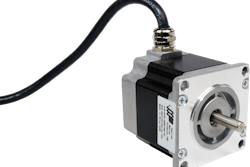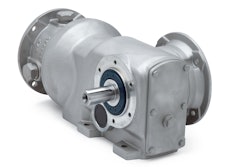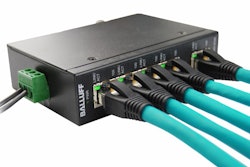In recent years, some robotic OEMs have looked for ways to obviate the need for this interface and simplify the controls package by using one PLC to control not only the packaging machinery components but the robot, too. Driving this trend was the simple fact that so many engineers are steeped in reading, programming, and troubleshooting PLCs. That being the case, why not do away with a proprietary robot controller and all the training time it involves-not to mention the need for the interface to the PLC--and let the oh-so-familiar PLC control the entire system? It was a trend that was especially noticeable at Pack Expo Las Vegas 2011, and it was talked about in the run-up to Pack Expo Las Vegas 2013, too. Yaskawa Motoman, for example, featured its MLX200 Next Generation Platform at the Vegas show, which is described as "a new way to program and control Motoman robots with Rockwell Automation's CompactLogix."
As interest in this PLC-based approach to robot control has gained traction, so has a countertrend that is based essentially on this premise: The elimination of the robotic OEM's controller eliminates all kinds of value-added functionality, including such things as collision avoidance, position and speed verification, ISO compliance, performance diagnostics, and so on. The other significant downside that has been recognized in the PLC-can-control-it-all approach is that when the robot stops working, who is supposed to support it: the robotic OEM, the packaging machinery OEM, the supplier of the PLC, or a Systems Integrator if there was one involved in the project?
Among the packaging machinery OEMs whose engineers generally take a dim view of PLC-based robot controls is Schneider Packaging Equipment. "We've used Rockwell PLCs to control some fairly simple robotic applications like two-axis pick-and-place or maybe a four-axis palletizer," says Schneider VP Controls Pete Squires. "In fact, Rockwell has made some real strides in the area of kinematics and robotic control with their Kinetix solution. But for anything more complex than the two-axis or four-axis applications I mentioned above, we stick with the controllers supplied by the traditional robotic OEMs because they have at their core such enormous horsepower directly related to motion, blended motion, collision detection, tracking, and so on, and they're very easy to implement."
One very welcome development in the past two years, says Squires, revolves around the interface between the packaging machinery's PLC and the robotic controller. "At least in the case of Rockwell and Fanuc," says Squires, "the interface tools have gotten much better. So now the two controllers can do what they're good at. The PLC handles point-to-point controls, and servo motions, and cammed motions while the robot controller handles complex kinematics. The machine operator or maintenance technician doesn't have to know or care how complex the robotic controller is. He just operates the machine at the touch screen because the handshake between Rockwell and Fanuc is so good."
According to Fanuc Senior Account Manager Dick Motley, this new interface tool is called EDA: Enhanced Data Access. "The end users who buy and operate these robotic packaging systems want it as easy as possible to get information out of the system that's meaningful to them, information that helps them measure uptime or troubleshoot faults. And to the extent possible, they want to see it on a single HMI. So what we've done with EDA software is make accessible to the PLC environment many more of the data types that historically have resided within our controller. It used to be pretty much discrete I/O and that was it. With this new software, robotic positioning can be looked at through the HMI of the PLC. The other thing that is really important is that with the old method you had to create the structure for basically every piece of data that you wanted to exchange between the two controllers. If you wanted an I/O point or a register value, for example, you had to set it up on both sides. What this new software allows you to do is define upfront in one shot all of the data you want to exchange between the two controllers. Then we export a file that goes into the RS Logics environment and creates all the structures for you. It eliminates quite a few steps."
Motley says the new interface is designed not only with the needs of the packaging machinery OEM in mind. It's also directed toward the end user community, where these robotic packaging systems spend actually spend their useful lives. Feedback from this community, says Motley, has been very encouraging.
"The feedback we're getting is that when little more than robotic I/O was accessible to the PLC environment, it meant that maintenance and operation people spent too much time dealing with two different control platforms," says Motley. "If they wanted to do something with general automation-infeed and outfeed, for example--they went and touched a Panelview or some other Rockwell interface. If they wanted to do something with the robot, they grabbed our hand-held pendant and interacted with that. This was perceived as a huge drawback from a training perspective, especially if there was personnel changeover and it all had to be demonstrated again to the new people. This EDA software makes so many more types of robot data and so much more robotic functionality available in the Rockwell environment that the PLC HMI becomes the touch point, if you will, for much of the robotic packaging system. Operators and maintenance people can do everything they need to for infeed, outfeed, or robotics--all from a Rockwell user interface."
Packaging machinery OEMs like the improved interface tool, as well. "In the past, Fanuc was always a bit more reserved in deciding what robot data would be accessible to the PLC interface," says Aaron Rondeau, Senior Controls Engineer at Pearson Packaging Systems. "I/O was about it. With this software they share a lot more robot information with the PLC, things like messaging alarms and string data. It makes it easier for me to use the PLC HMI as a robotic interface. I used to have to jump through too many hoops to get that kind of robotic information to the PLC. EDA is essentially a tool that allows the robot controller to talk over an Ethernet connection to the Rockwell controller. The PLC doesn't 'control' the robot, but the PLC can see a lot more data about the robot's status and operating conditions."
Squires, who is an equally big fan of the EDA software, sums it all up this way. "I've always told Fanuc, 'Look, your robot controller can do a few of the things a PLC is good at.' And I've always told Rockwell, 'Yeah, your PLC can do a little robotics.' But the fact is, each controller plays a different role and makes a different contribution. They complement each other, and I think that with this new interface tool, they're more complementary than ever before."


























